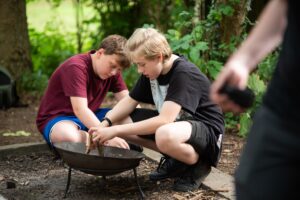Chris King is a teacher, mindfulness practitioner and storyteller. He works with Alliance Psychological Services and has contributed material towards WellBeings, an online programme that delivers a whole school approach to mental health and emotional wellbeing.
Here he tells us how understanding how our brains work can help us support military children during periods of change and stress.
I remember, when I was 9, feeling lost and very afraid.
From a warm home in the south of England, overnight I found myself living in a small, crowded caravan in the northeast.
My home was gone, my friends were hundreds of miles away, there was no room for my toys, and my dad was away. Nothing was familiar, while the prospect of a strange new school simply added to my building anxiety. I retreated into my shell, but like a smouldering volcano it didn’t take much for me to erupt to a wild level of anger that was out of character and made things difficult for both my parents and teachers.
Moving is one of the greatest stressors we face, and for children particularly so as you step frequently from the familiar to the unknown.
Stress can have a massive impact on how the brain works, causing behaviour to seesaw rapidly from calm compliance to reactive disruption. If, however, we can give children and parents a simple explanation of what is happening, we can empower both to understand and have compassion for what is a natural process, while promoting the skill of self-regulation.
As a storyteller, I find the easiest way to explain the complexities of the stressed brain to children is to use helpful characters.
I explain that a part of the brain can be thought of as a guard dog who wants to keep us safe. We call that part of the brain the amygdala.
We can perhaps imagine the guard dog standing beside a door through which information from our senses pours into the brain like letters falling through the letter box. The guard dog gives them the equivalent of a good sniff and if everything seems safe, carries the information to a clever part of the brain that opens the mail and works out a clever solution. This part of the brain is called the pre-frontal cortex and we can think of it as our wise owl.
So, if for example, a teacher asks a simple question, that to the guard feels is safe and easy, such as what is 6 + 11, the dog swiftly runs to the owl who works out the answer. The dog is happy and you feel calm and peaceful. Brilliant!
But if something comes through the door of the brain that, to the amygdala guard dog, feels is unsafe and maybe dangerous, then a very different outcome can happen. Perhaps somebody is calling you names, or a challenging maths problem just doesn’t seem to have an answer, or you find yourself somewhere unfamiliar and strange.
Now your guard dog feels threatened and may begin to growl and bark.
You can notice this, because your guard dog will tell you, not in words but through changes in your body. You might find that your heart begins to beat faster, your breathing might become rapid, and you may begin to sweat, or clench your fists etc.
If the name calling develops into pushing or that maths question seems even more complex, the amygdala dog is likely to become ever more agitated. Perhaps you can imagine it barking even louder, jumping up and down, which then disturbs the owl so much that it flies away.
Oh dear. Without the advice of the wise owl, the poor guard dog can’t think clearly and will react by fighting, running away or freezing. You might find yourself shouting, using unpleasant words, lifting your fists, or just standing there, as if frozen.
So, what can you do to help?
- Learn to listen to the guard dog. It speaks to us all the time. Notice how your body feels when you are calm and relaxed, and again when you feel nervous, angry, or upset. If you find yourself reacting without any thought, then you know the owl has flown away and left the dog by itself.
- Find some effective grounding tools (see below) which help you to pause and reduce the risk of a damaging reactive response. It’s a bit like patting the dog and reassuring it.
- Encourage talking and the sharing of problems.
When we find ourselves somewhere strange and unfamiliar, it is very easy for the inner guard dog to bark and bark continuously. It’s afraid and is likely to react without any thought. By listening to the body, however, we can learn to listen to the guard dog, keep the wisdom of the wise owl and choose how best to respond to a situation. In this simple way we can develop greater emotional resilience and encourage self-regulation.
For more information on grounding, see the section on mindfulness tools within ‘Little Troopers’ or go to WellBeings, a programme which supports positive mental and emotional health in primary schools, for children, parents and teachers.






